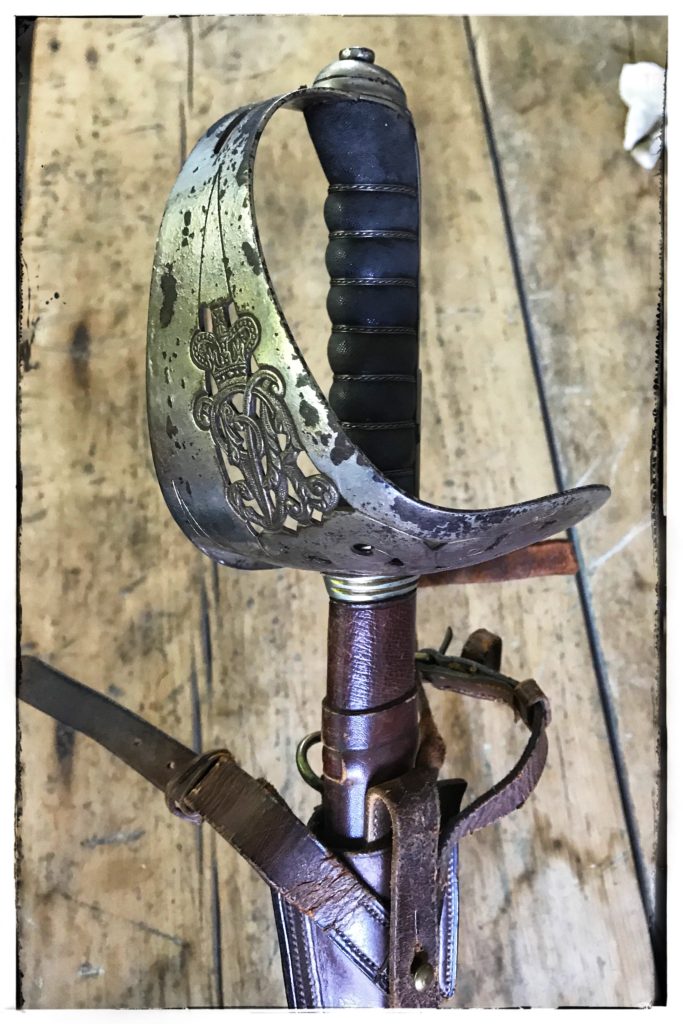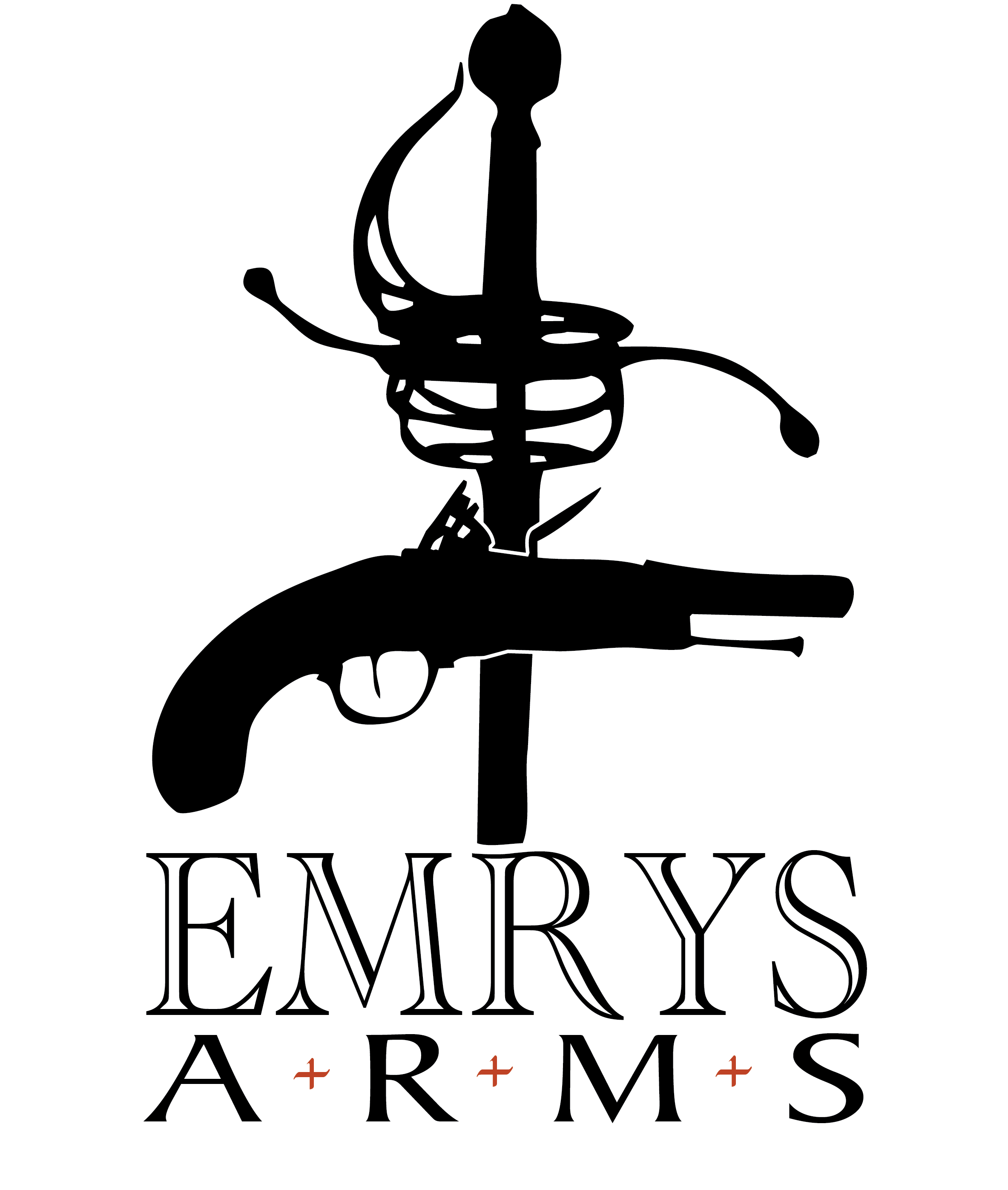| Collection #: | 2020.014 |
|---|---|
| Type: | Infantry Sergeant |
| Nationality: | British / Canadian |
| Pattern: | 1898 |
| Sub-Pattern: | 1898 for Staff Sergeants |
| Date: | 1901 |
| Hilt: | Plated Steel |
| Blade Length: | 82.3cm (32 3/8") |
| Blade Width: | 2.7cm (1 1/16") |
| Overall Length: | 99cm (39") |
| Inspection: | Original Markings for Wilkinson |

The 1898 pattern. Based on the final pattern of sword for the British infantry. To fully appreciate it, however, we need to first look at its brief predecessor, the 1895 pattern. With the introduction of a new blade style in 1891/92, it was time for the aging hilt style of the 1845 pattern (or technically the 1845/54 or 1854 pattern – depending which author you read) to evolve as well. “In 1895, in the form of a plated steel, three-quarter basket hilt, in a scroll pattern made up of pierced strapwork incorporating a crown and royal cypher, [was achieved]. It gave excellent protection to the hand although a critic might claim that the pierced strapwork might still allow a sword or lance point to penetrate. Nevertheless, taken as a whole, the Pattern 1895 sword, with it’s excellent guard and its wicked, thrusting blade, was unquestionably the best fighting sword ever prescribed for the infantry officers of the Army, and its theoretical excellence was confirmed in practice.”
The 1895 pattern only lasted a couple of years before a modification was adopted which saw the edge of the steel guard turned down to prevent the fraying of the uniform. This seems to have been a common theme throughout the 19th century regarding the adoption of new swords in the British Army and Cavalry – the adjustment of the guard to prevent fraying and wear on the uniform. The rigid shell guard version of the 1786 pattern infantry sword evolved into the 1796 pattern with one shell guard folding down. Then the 1822 pattern infantry sword (replacing the 1796 pattern) with the folding guard, but then losing that folding guard in the modification of 1854. The 1864 pattern cavalry sword introduced a new design to the cavalry, which eventually resulted in a modification to rolling down the edges of the guard in the 1882 pattern (see the 1890 pattern as I do not own an 1882 pattern yet, but the guard is essentially the same). Finally, we have the guard altering one last time from the 1895 pattern infantry sword to the 1897 pattern.
This is a standard 1898 pattern infantry sword. A few clues reveal to us what is present and what is not present. For starters, the blade is completely lacking in any decoration. No retailer’s marks, royal cyphers or inscriptions. Secondly, there are numerous government ownership, regimental and proof marks. While an officer’s sword can reveal much to us if we have the luxury of a name or regiment inscribed to the blade or one of those sought-after Wilkinson numbers to the spine (which may or may not reveal results), so too can government markings.
The fact that the blade is completely plain, tells us that there is a distinct possibility, that this is the sergeants’ version of this pattern. Robson tells us that “an entirely new design of dismounted officers’ sword was introduced in 1895-97, and the same design was adopted for all sergeants of dismounted corps (except Highland) in October 1897 as the Sword, Staff-Sergeants’ Pattern 1897. The plain blade is 32 9/16 inches long, with the single fuller starting about 1 3/4 inches from the shoulder and finishing about 18 inches from the spear point. The 5 1/4 inch hilt is identical with that of the officers’ sword” (Robson, page 217).
There would continue to be further modifications to the blade such as an altering of the weight and the rigidity of the blade. Thus the 1897 for Staff-Sergeants’ “was rapidly replaced by the Sword, Staff-Sergeants’, Pattern 1898 in November 1898 which had a heavier and stiffer blade … weighing 2lbs 1/2 oz. …and was designed to withstand a testing pressure of 30lbs as against 22lbs…” (Robson, Page 217) and the thickness was altered. Then again the sword was modified and “the Sword, Staff-Sergeants’, Pattern 1898, Mark I – was introduced in 1902. It differed only in having a Tudor Crown in the guard instead of St. Edward’s Crown and the cypher of Edward the VII in place of that of Queen Victoria” (Robson, page 217).
The reason to go into all these details is to show how we can utilize the information we have to help us identify whether this is the 1897, 1898 or 1898 Mark I (1902) Staff-Sergeant sword. On the left side of the ricasso, we see the date 12 ’01 and a separately stamped ’02 giving us a date of December 1901 and reissue in (possibly early) 1902. This evidence, along with the royal cypher of Queen Victoria still present, makes this piece, according to the List of Changes, most likely the 1898 pattern introduced originally on 16th of August, 1898 while the Mark I would be introduced 20 August 1902, (Skennerton, Ian. British Service Sword & Lance Patterns. Page 19).
This example is in sturdy condition, with the plated steel guard with some corrosion. The fish skin and wire grip are complete and intact with smoothness from age and use. The grip is very straight compared to Sword 2020.015 which is later in date and much more contoured to the grip of the hand. The backstrap is chequered halfway up for better grip with the thumb. The guard has the royal cypher of Queen Victoria. The rear lip of the guard (where the rear quillon would normally be) has two sets of regimental markings. The first set at the base of the ferrule, is heavily scratched out and appears to be /’02 over 5(?) R.C.E. over another number which is too obliterated. Further down we have 3.38 over 6 R.C.E. over 5. This sword has spent some time with the Royal Canadian Engineers, I’ll get into a bit of history and dating this sword below, but first…
The needlepoint 82.5 cm blade is completely clean and free of rust. The blade contains numerous markings. To the right side, we have an X to denote that it passed its bending test. To prevent overstraining of the blade after initial testing, it was determined in 1885 that on any future tests of the blade, only one side was to be tested, the side with the X (Robson, page 279). Above this marking is a crown surmounting the number 49 over a W. This is the view mark placed after assembly showing that the sword had been inspected by viewer 49 (inspector for quality control) at Wilkinson. Above this is a broad arrow, denoting Government ownership. On the left side ricasso, we have 12 ’01, telling us it was put into service in December 1901. Above that we have a crown over 35 over W; it went back to Wilkinson for inspection at some point and was cleared by viewer 35. Sideways we have an ’02 for reissue in 1902. Sideways as well beside that mark (and probably done at the same time) is a crown over (?)8 over E for viewing at Enfield. Further up the ricasso we again have a crown over 49 over W; the original viewer of the sword who would have placed this mark on the blade when it was in its initial stiffened state. For a full explanation of these markings; other markings and why they are where they are, see Brian Robson’s book Swords of the British Army 1788-1914 The Revised Edition.
The brown leather Sam Browne scabbard is in relatively good condition. It has a stepped, steel throat with the frog attached; the frog marked “KELLY’S HALIFAX”. Halfway down there are some slices to the scabbard leather. Most of the stitching has let go along the seem revealing the wood core to the scabbard. On the back, below the throat are the markings 3.38 over 6.R.C.E. over 2. Below that is a broad arrow inside a C denoting Canadian Government ownership. This was adopted before WWI, but I am unsure of an exact date. It seems to have been discontinued officially in 1949, though later examples exist.
Back to the history/timeline of this example. “Dress Regulations for 1900 prescribed the Pattern 1897 infantry hilt for the Royal Engineers so that the date of changeover [from the previous Pattern 1857 Engineers’ sword] took place sometime between 1897 and 1900. In 1899 the Engineers, along with all other branches of the Army had adopted a brown leather scabbard with steel mounts [the locket and the chase, that is] for use with the Sam Browne belt and Service Dress; the steel mounts, however, disappeared in 1900. There were no further changes to the Royal Engineers’ sword after 1900” (Robson, pages 235, 237). In Canada, “in 1904, His Majesty the King honoured the Corps by adding the prefix “Royal”, making them the Royal Canadian Engineers (RCE)” (Veterans Affairs Canada). So we have some transitions going on here in the life of this sword. First, we have the shift of military engineers adopting this pattern somewhere between 1897 and 1900. Then we have the changeover of monarch in early 1901(in regards to the royal cypher on the guard), we have the issuance of the sword into service in December 1901, we have it re-issued in 1902 and the designation to the Royal Canadian Engineers which can be no earlier than 1904. On top of that in the background, we have the distant (at least geographically in Canadian terms) Boer War concluding.
There you have it, if you have stayed awake, you now know more than you ever realized you wanted to know about the Pattern 1898 sword for Staff-Sergeants’.
We use cookies to improve your experience on our site. By using our site, you consent to cookies. Enjoy the cookies...they're delicious...
Websites store cookies to enhance functionality and personalise your experience. You can manage your preferences, but blocking some cookies may impact site performance and services.
Essential cookies enable basic functions and are necessary for the proper function of the website.
Statistics cookies collect information anonymously. This information helps us understand how visitors use our website.
Google Analytics is a powerful tool that tracks and analyzes website traffic for informed marketing decisions.
Service URL: policies.google.com (opens in a new window)

